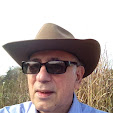
Quincy California 'Snow-Bowl' with Airport in Center
Airport is 80 miles from My Former Home in Paradise

Johnny Moore, Manager of Sugarpine Aviators in Quincy
in a Photo Dated 1967 at Benton Airport in Redding, Ca.
"We do get a number of you flatlander wanna- be pilots at our Sierra airport" beamed Johnny Moore, crop dusting pilot, Alaska bush pilot, fire bomber pilot, author and Manager/Owner of the
Sugarpine Aviators Flight School at Quincy, California's Gansner Airport-- on my first meeting with him.
He continued: "We will take you to proficiency and your ticket in just a few days."
I found these statements bewildering and confusing! I must admit, I was incredulous based on my experiences until now! Read on and, hopefully you'll understand.
I was at a loss for words. I had no idea what he was talking about. You see, all I knew was 16 months had elapsed since I had started on my private pilot's license journey on my birthday May 24, 1978 and I felt I was getting nowhere fast.
Yes, my instructor at Chico Airport was competent (he was flying charter) and guided me on my first solo flight on July 8th (what a super feeling!), my first dual cross county on August 11th: CIC/Chico, CCR/Concord, Hayward, Oakland, Napa and CIC) logging 3.9 hours with the logbook notation: 90 day-OK. This was followed by my own Cross Country solo on August 11th in 387 Charlie: CIC. Lincoln, Woodland and then CIC, ( 2.6 of tachtime). Then two more solo short cross country flights with my August 20th one totalling 4.9 hours. Only my long Cross Country lay ahead of me. I was buoyant.
Wow, with such accomplishments under my belt, I thought I would be ready to go for my private pilot's checkride in another 30 days. In fact on October 4th, I completed my 5.7 hour Long Cross Country from Chico to Fresno to Hayward back to Chico.
But then, a strange thing happened: though I was flying with my instructor three times weekly through February 1979 and accumulating a staggering 90, yes, ninety hours of flight time, I was getting nowhere fast; or, as my instrument instructor Al Stockstead of Eugene, Oregon was fond of telling me: 'You don't need to bore holes in the sky."
(BORING FOR ME, INDEED)
I recall one training session at Willows Airport where we practiced cross wind landings (35-45 MPH winds blowing across the runway) for 90 minutes. Though my instructor, with much concentrated effort, was able to land our trainer consistently, I failed in four attempts. Naturally, I came away disheartened.
After all, I was responsible for the predicament I was in: I loved flying, I was naive and, above all, flying was inexpensive then... so I suppose I stayed with him much longer than I should have. On July 8, 1979, after doing some VOR tracking and short field takeoffs, I made up my mind to locate another instructor. As luck would have it, I chanced by Quincy Airport where I had been transacting some business; here I met Johnny and his assistant Tom Rahn; I took a flight with Johnnie and liked him immediately.
I spent a week at Quincy Airport early in October, flew twice daily with Tom. Withing four days, they certified me and voila, I earned my wings. I mean to say I earned my wings the hard and long way.
Johnny and Tom later explained to me that my instructor was using my flight time to build up time towards his ATP rating so he could fly big planes for the big airlines. Teaching me was secondary to his career. And this explains, my increasing frustration after flying with him.
At Sugarpine Aviators Flight School, I realized that teaching came first and my instructors imparted their love, devotion and precision mountain flying to me. Their student focused work ethic was so evident that I came away not only with my 'ticket' but a love and appreciation of my skills.
Within 6 months I owned my own plane: A Piper PA-28-181, Archer II with dual Navs/Coms, DME and low tach and engine time.
How is that for turning things around! Learn from my experiences, check out your instructor first. Be sure his main preoccupation is you --the student! If not, continue your quest for a full time instructor.
And, secondly, don't sweat the time. Though you can get your ticket in as little as 40 hours, 60-90 hours is perhaps more realistic. So hang in there as I did.....it's well worth it.
As a post script: Johnny has published three books: his first is Breaking Into Agricultural Aviation, which he autographed for me. His second is a classic on his aviation experiences entitled I must Fly which makes for fun, hilarious and serious reading
My blogs on aviation include articles on:
A Salute to All American Veterans,
The Plane: The Ultimate Time Machine,
The P-51 Mustang: 65 Years Later and its World War II Flying Aces,
Chuck Yeager's 86th Birthday Flying Feat,
Doolittle's Raiders Celebrate 68th Reunion,
Lindberg Earns The Congressional Medal of Honor,
The New Biomass Alternative Avgas Pioneered by Swift Enterprises Ltd. Coming up shortly articles on Frank Luke, World War I,
US flying ace, Jackie Cochran, first aviatrix to break the sound barrier and Glenn Curtiss, aviation pioneer and founder of Curtiss Aeroplane and Motor Company, now part of Curtiss Wright Corporation. Stay tuned.














